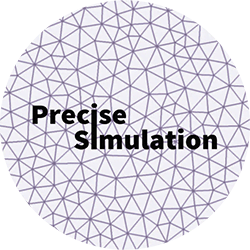
|
FEATool Multiphysics
v1.17.5
Finite Element Analysis Toolbox
|

|
FEATool Multiphysics
v1.17.5
Finite Element Analysis Toolbox
|
EX_NAVIERSTOKES16 2D Example for stationary flow around a cylinder with an attached beam.
[ FEA, OUT ] = EX_NAVIERSTOKES16( VARARGIN ) Stationary flow around a cylinder with an attached solid beam.
[1] Hron J. A monolithic FEM/multigrid solver for ALE formulation of fluid structure interaction with application in biomechanics. In H.-J. Bungartz and M. Schäfer, editors, Fluid-Structure Interaction: Modelling, Simulation, Optimisation, LLNCSE. Springer, 2006.
Accepts the following property/value pairs.
Input Value/{Default} Description
-----------------------------------------------------------------------------------
hmax scalar {0.025} Grid size
sf_u string {sflag1} Shape function for velocity
sf_p string {sflag1} Shape function for pressure
iplot scalar 0/{1} Plot solution (=1)
.
Output Value/(Size) Description
-----------------------------------------------------------------------------------
fea struct Problem definition struct
out struct Output struct
cOptDef = { ...
'hmax', 0.025;
'sf_u', 'sflag1';
'sf_p', 'sflag1';
'iplot', 1;
'tol', [0.1 0.1];
'fid', 1 };
[got,opt] = parseopt( cOptDef, varargin{:} );
fid = opt.fid;
rho = 1e3;
miu = 1;
umean = 0.2;
diam = 0.1;
% Geometry.
fea.sdim = { 'x', 'y' };
gobj1 = gobj_rectangle( 0, 2.5, 0, 0.41, 'R1' );
gobj2 = gobj_circle( [0.2 0.2], diam/2, 'C1' );
gobj3 = gobj_rectangle( [0.2], [0.6], [0.2-0.01], [0.2+0.01], 'R2' );
fea.geom.objects = { gobj1 gobj2 gobj3 };
fea.geom = copy_geometry_object( 'C1', fea.geom );
fea.geom = copy_geometry_object( 'R2', fea.geom );
fea.geom = geom_apply_formula( fea.geom, 'R1-C1-R2' );
fea.geom = geom_apply_formula( fea.geom, 'R3-C2' );
% Grid generation.
fea.grid = gridgen( fea, 'hmax', opt.hmax, 'gridgen', 'gridgen2d', 'fid', opt.fid );
% Equation settings.
fea = addphys( fea, @navierstokes );
fea.phys.ns.sfun = { opt.sf_u, opt.sf_u, opt.sf_p };
fea.phys.ns.eqn.coef{1,end} = { rho, 0 }; % Density.
fea.phys.ns.eqn.coef{2,end} = { miu, 0 }; % Viscosity.
fea.phys.ns.prop.active = [ 1, 0; 1, 0; 1, 0 ];
% Boundary settings.
fea.phys.ns.bdr.sel = [ 1 3 1 2 ones(1,9) ];
fea.phys.ns.bdr.coef{2,end}{1,4} = ['1.5*',num2str(umean),'/(0.41/2)^2*y*(0.41-y)'];
% Solver.
fea = parsephys(fea);
fea = parseprob(fea);
fea.sol.u = solvestat( fea, 'fid', opt.fid ); % Call to stationary solver.
% Postprocessing.
s_velm = 'sqrt(u^2+v^2)';
if ( opt.iplot>0 )
figure
subplot(2,1,1)
postplot( fea, 'surfexpr', s_velm )
title( 'Velocity field' )
subplot(2,1,2)
postplot( fea, 'surfexpr', 'p' )
title( 'Pressure' )
end
% Calculate benchmark quantities (line integration method).
s_tfx = ['nx*p+',num2str(miu),'*(-2*nx*ux-ny*(uy+vx))'];
s_tfy = ['ny*p+',num2str(miu),'*(-nx*(vx+uy)-2*ny*vy)'];
i_int = [5:8,11:13]; % Integration boundaries.
i_cub = 10;
F_d1 = intbdr(s_tfx,fea,i_int,i_cub,size(fea.sol.u,2),1);
F_l1 = intbdr(s_tfy,fea,i_int,i_cub,size(fea.sol.u,2),1);
% Calculate benchmark quantities (volume integration method).
% Create field 'a' with values one on the cylinder and zero everywhere else.
fea.dvar = [ fea.dvar, {'a'} ];
fea.sfun = [ fea.sfun, fea.sfun(1) ];
fea = parseprob(fea);
n_dof = max(fea.eqn.dofm{1}(:));
[~,ind_gdof] = evalexprdof(0,1,fea,i_int);
u_a = zeros(n_dof,1);
u_a(ind_gdof) = 1;
fea.sol.u= [fea.sol.u;repmat(u_a,1,size(fea.sol.u,2))];
fea.eqn = struct;
fea.bdr = struct;
fea = parseprob(fea);
s_tfx = ['ax*p+',num2str(miu),'*(-2*ax*ux-ay*(uy+vx))-(u*ux+v*uy)*a'];
s_tfy = ['ay*p+',num2str(miu),'*(-ax*(vx+uy)-2*ay*vy)-(u*vx+v*vy)*a'];
F_d2 = intsubd(s_tfx,fea,1,find(fea.grid.s==1),3);
F_l2 = intsubd(s_tfy,fea,1,find(fea.grid.s==1),3);
if( ~isempty(fid) )
fprintf(fid,'\n\nBenchmark quantities:\n\n')
fprintf(fid,'Drag force, Fd = %6f (l), %6f (v) (Ref: 14.929)\n',F_d1,F_d2)
fprintf(fid,'Lift force, Fl = %6f (l), %6f (v) (Ref: 1.11905)\n',F_l1,F_l2)
end
% Error checking.
out.Fd = [F_d1 F_d2];
out.Fl = [F_l1 F_l2];
out.err = [abs(out.Fd-14.929)/14.929;
abs(out.Fl-1.11905)/1.11905];
out.pass = (out.err(1,2)<opt.tol(1))&(out.err(2,2)<opt.tol(2));
if ( nargout==0 )
clear fea out
end